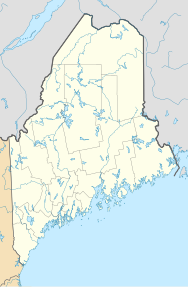Oxford, Maine
| Oxford, Maine | |
|---|---|
| Town | |

Congregational Church, c. 1909
|
|
| Location within the state of Maine | |
| Coordinates: 44°07′37″N 70°29′42″W / 44.12694°N 70.49500°W | |
| Country | United States |
| State | Maine |
| County | Oxford |
| Incorporated | 1829 |
| Area | |
| • Total | 41.88 sq mi (108.47 km2) |
| • Land | 38.72 sq mi (100.28 km2) |
| • Water | 3.16 sq mi (8.18 km2) |
| Population (2010) | |
| • Total | 4,110 |
| • Estimate (2012) | 4,083 |
| • Density | 106.1/sq mi (41.0/km2) |
| Time zone | Eastern (EST) (UTC-5) |
| • Summer (DST) | EDT (UTC-4) |
| Website | www.oxfordmaine.org |
Oxford is a town in Oxford County, Maine, United States. The population was 4,110 at the 2010 census. Oxford is home to the Oxford Plains Speedway, the annual Oxford County Fair, and Oxford Casino. The town includes the village of Welchville.
The land was part of Shepardsfield Plantation (also called Bog Brook Plantation), granted on March 8, 1777 by the Massachusetts General Court to Alexander Shepard, Jr. of Newton, Massachusetts. On March 6, 1792, the plantation was incorporated as Hebron, with Oxford its southwesterly portion. First settled in 1794, Oxford was set off and incorporated on February 27, 1829. It annexed land from Otisfield in 1830, and from Paris in 1838. The town was named after Oxford, in England.
Farmers grew mostly hay, and the town became noted for cattle. Mills were established at 2 water power sites; these developed in the 19th-century into principal villages within the town, especially after the arrival of the Grand Trunk Railway in the 1850s. Welchville was located on the Little Androscoggin River, where the woolen textile mill of the Harper Manufacturing Company was established. At the outlet of Thompson Lake was Oxford village, first called Craigie's Mill for the sawmill and gristmill built by Andrew Craigie, a Boston apothecary and land speculator. This was also the site of a grisly murder that, to this day, goes unsolved. Here were erected a barrel stave mill, a shovel handle factory, and the woolen textile mills of the Robinson Manufacturing Company. The railroad brought seasonal tourists to Thompson Lake, where inns and hotels opened. Today, Oxford is a recreational area with fine architecture remaining from its prosperous mill town past. The Congregational Church, built in 1842–1843, is listed on the National Register of Historic Places.
...
Wikipedia

